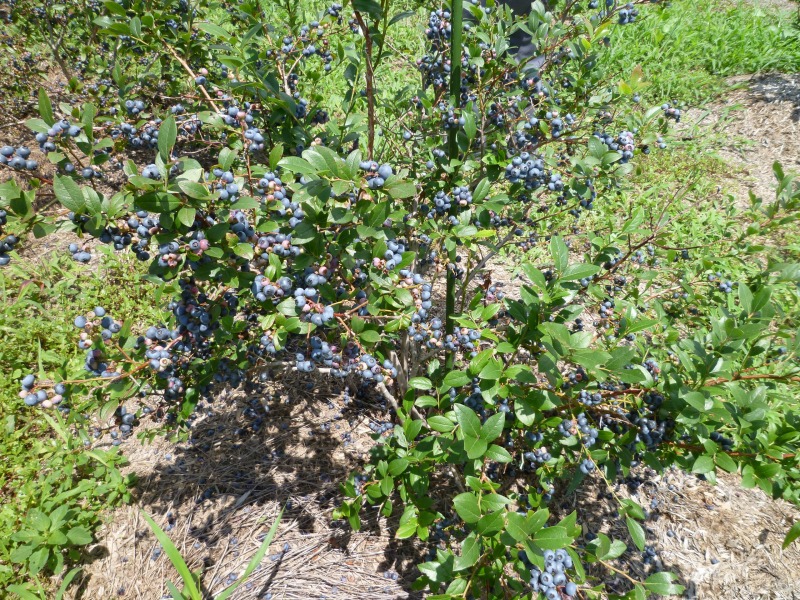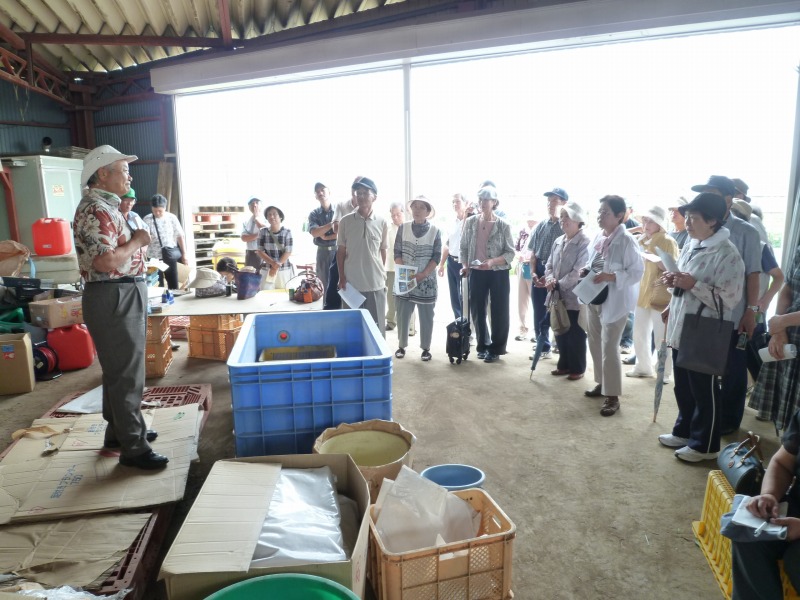Radiation would not walk away; therefore, EM effects can be easily evaluated after application. However, the municipal governments in the affected areas did not even try EM application. Therefore, my team obtained an agreement with a farmer in Iidate village which is designated as “planned evacuation zone” to conduct an experiment of EM application to a plot of 24a blueberry field.
Meantime, EM volunteers in Fukushima prefecture have sprayed EM at home gardens and schoolyards for self protection. There are quite many EM farmers in Fukushima prefecture, and those who lived in high radiation level have cooperated with us to develop effective ways to apply EM to eliminate radiation. I visited them on August 5th to discuss the results which I report here.
1. The Results in Iidate Village
A summary report is presented here, while a detail report will be presented in October. A plot of 24a blueberry field was divided into a control section (with no EM application) and two experimental sections (with EM application). The experiment began in the 2nd week of May by making twice-a-week spraying of a mixture of 80 parts EMA (EM activated) and 20 parts phototrophic bacteria solution: 100L of the mixture per 10a in one experimental section and the same amount of the mixture with one time application of 250Kg rice bran per 10a in other experimental section.
The preliminary measurement showed that cecium-137 level reached 20,000Bq per 1Kg soil. In order to reduce the radiation down below 5,000Bq (considered allowable for farming by Japanese government), EM mixture was sprayed twice per week. Interim report presents the results after 19 sprays (in about two months). Soil sampling was made in accordance with the sampling standards for environmental data prescribed by the Ministry of Education and Science and sent to a highly reputable Isotope Research to determine the level of cesium-137.

(1-1) The Field Experiment in Iidate Village
The results were as follows. The level of 20,000Bq decreased by 40% in one month and by 75% by the end of the 2nd month to 5,000Bq which was allowable for planting rice. Farming is allowable now.
A half-life of cesium-137 is about 30 years. When left as is in the nature, the level in the experimental field will be 10,000Bq after 30 years. It will take 60 years to reach the level of 5,000Bq.
Other than rice farming, allowable level of radiation exposure has not been established for other crops and vegetable farming. The allowable level of cesium-137 for farm and marine produce is set below 500Bq. Needless to say; it is desirable when “not-detected”.

(1-2) Bountiful Blueberry (Allowed for Sale)
The measurements of the harvested blueberry from the experimental fields showed: 341Bq from the section of EM mixture application, 203Bq from the section of EM mixture and rice bran application, and over 500Bq from the control section.
2. EM Farmers of “Agri-SCM Fukushima prefecture”
The blueberry experiment in Iidate village was made in the field where no EM had been applied prior to the experiment. The experiment has proved that EM application could reduce the high contamination level of 20,000Bq down below the allowable level in several months. EM is effective against radiation exposures. In the area of Date city of Fukushima prefecture, there are many farmers who have used EM well over 15 years. Mr. Makuta Takehiro has organized about 50 EM farmers under a supply chain management called “Agri-SCM”. The recent Tsunami and earthquake has forced approximately 10 farmers out of farming, leaving only 40 farmers in the group.
In order to prevent unfounded conjecture, Mr. Makuta took the harvested crops and vegetables of “Agri-SCM” farmers to Isotope Research for radiation measurement, all of which results showed “not-detected”. According to Mr. Makuta, some farm products from low contamination areas have shown high concentration above the allowable level when EM application has not been made. All EM applied farm products from Kohriyama and Fukushima cities have proved “not-detected” level of radiation, which seems to indicate that EM farming can solve radiation problems.
I would like to introduce a case that radiation has some benefit when EM is applied. At completion of experiments in Belarus in 2000, I made a comment, “Plants do not absorb radioactive substances when EM is applied extensively in the field exposed to radiation. But they grow to gain ability to use radiation as source of energy like solar energy and increase productivity.” It was based on the fact that the wheat grown in the highly contaminated areas of Belarus produced greater yield.
This trend was also noted in the neighboring Russia as well as in Fukushima prefecture. It rained a lot and did not provide enough hours of sunshine in Fukushima prefecture this year. It is the worst condition for growing fruits. But, EM fruit growers have experienced less insect damages and made very good harvest. All they need is willing customers. The same applies to cucumber and tomato harvests. Considering these cases, radiation could serve as a source of energy when EM is applied and provide healthy produce.
3. EM Sunflower Project in Kashima Area of Minami-Souma City
I mentioned in my message No. 46 about EM Sunflower Project. Because of continuous rain, growth was bad in some parts. The radiation level in Kashima area was about 800Bq. We determined, after some discussion, that only several EM applications would be sufficient to reduce the level to that of “not-detected”. Therefore, we decided that we would apply EM again in autumn when we plow sunflower and weeds into soil and that we would not go for oil production. Plowing with EM will facilitate fermentation to use sunflower as organic fertilizer. EM will be applied in the future production. We expect improved quality and increased yield in production of the next year as well as reduction in the level of radiation.

(3-1)Sunflower farm in Kashima Area of Minami-Souma City
4. Reports from EM Volunteers
Many EM volunteers who spray EM to home gardens and schoolyards have radiation meter and reported their findings. An initial EM spray gives an air of improvement, and repeated spraying to surface soil for several months has reduced the level of radiation from 6micro-sieverts/hr to 0.5micro-sieverts/hr or “not-detected”. Radiation level of pavement surface has been reduced to a half after EM application. No report that we received was negative. Some recommended such experiment for kids’ summer project. We feel confident that EM can deal with radiation problems.

(4-1) Discussion with Farmers and EM Volunteers of Fukushima Prefecture to Countermeasure Radiation
U-net (a not-for-profit organization) has decided to strengthen the activities of EM Eco Kooriyama and set up 8-10 EM activation centers in Fukushima prefecture. With cooperation of Women’s Section of Fukushima Chamber of Commerce and EM volunteers, a system to provide EM to eradicate radiation contamination in the prefecture has started to move forward.
5. Highly Contaminated Sludge
An interesting report was filed by Iwate Compost co. located in Hanamaki city of Miyagi prefecture. The company applied EM in building its facilities and has applies EM in turning sludge to fertilizer for more than 15 years. EM has helped to turn heavy metals, dioxin, and other chemicals harmless.
With cooperation of EMRO (EM Research Organization), EM-Seikatsu (a sales company of EM and EM goods), and U-net, the company has been producing and delivering approximately 500tons of EMA to the affected areas of Iwate prefecture since March. EM compost that the company produces (called cosmo-green) is as effective as EM Bokashi and used for reducing foul odor of toilets and putrefied marine products as well as to eradicate saline problems in farm field.
Sludge brought to Iwate Compost co. usually records 200Bq before processing, but ”not-detected” level after going through 30 day process with EM application. EM density in Iwate Compost products is much higher than the density of EM that effectively reduced radiation level in Iidate village.
Reviewing these reports, I believe that highly contaminated sludge, as high as 50,000Bq, could be turned into good organic fertilizer in 30 days with EM application. It can easily be tested.
We file these reports to the Ministry of Agriculture, Forestry and Fisheries and hope that they will give serious consideration for EM application.
記事一覧へ
